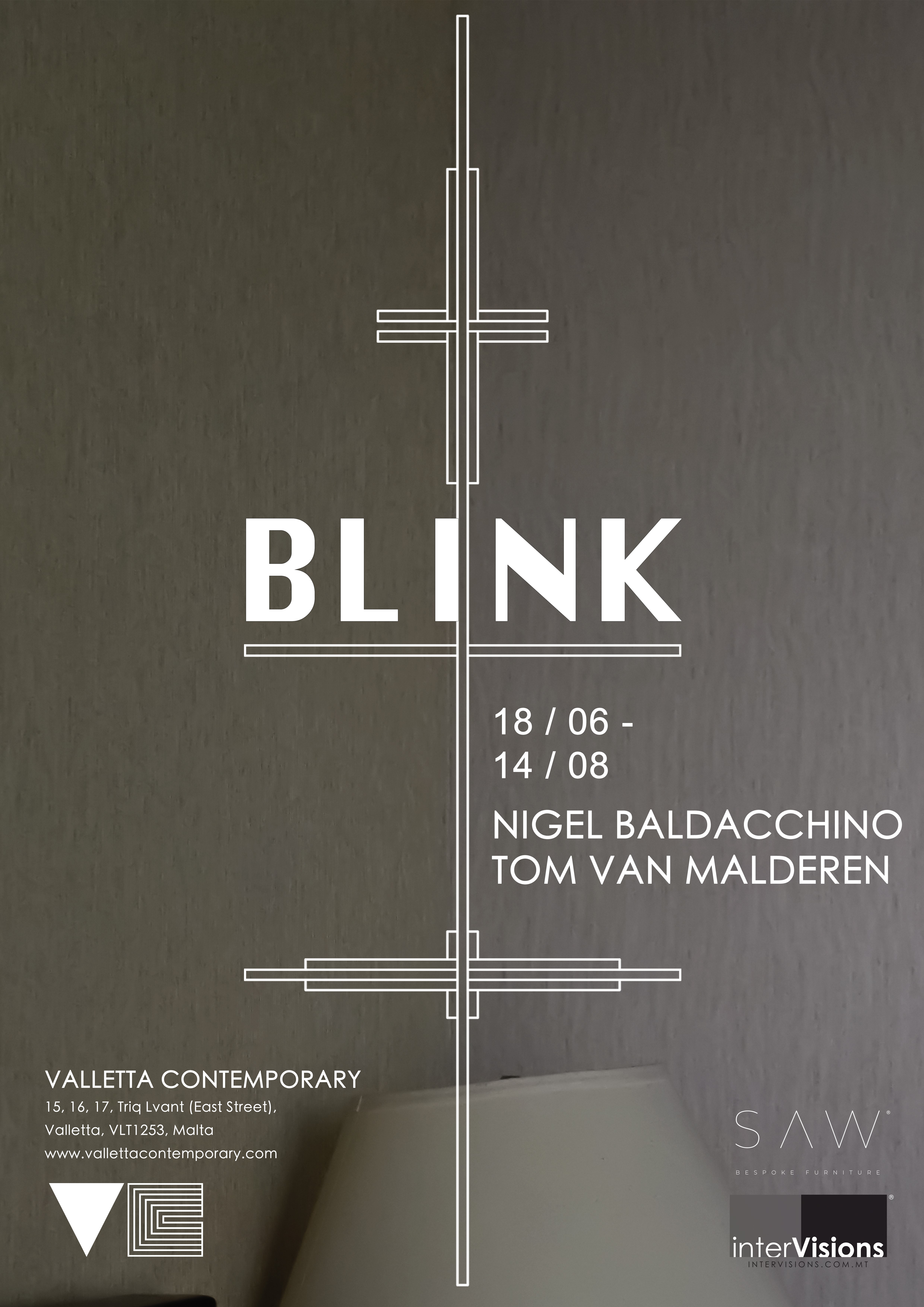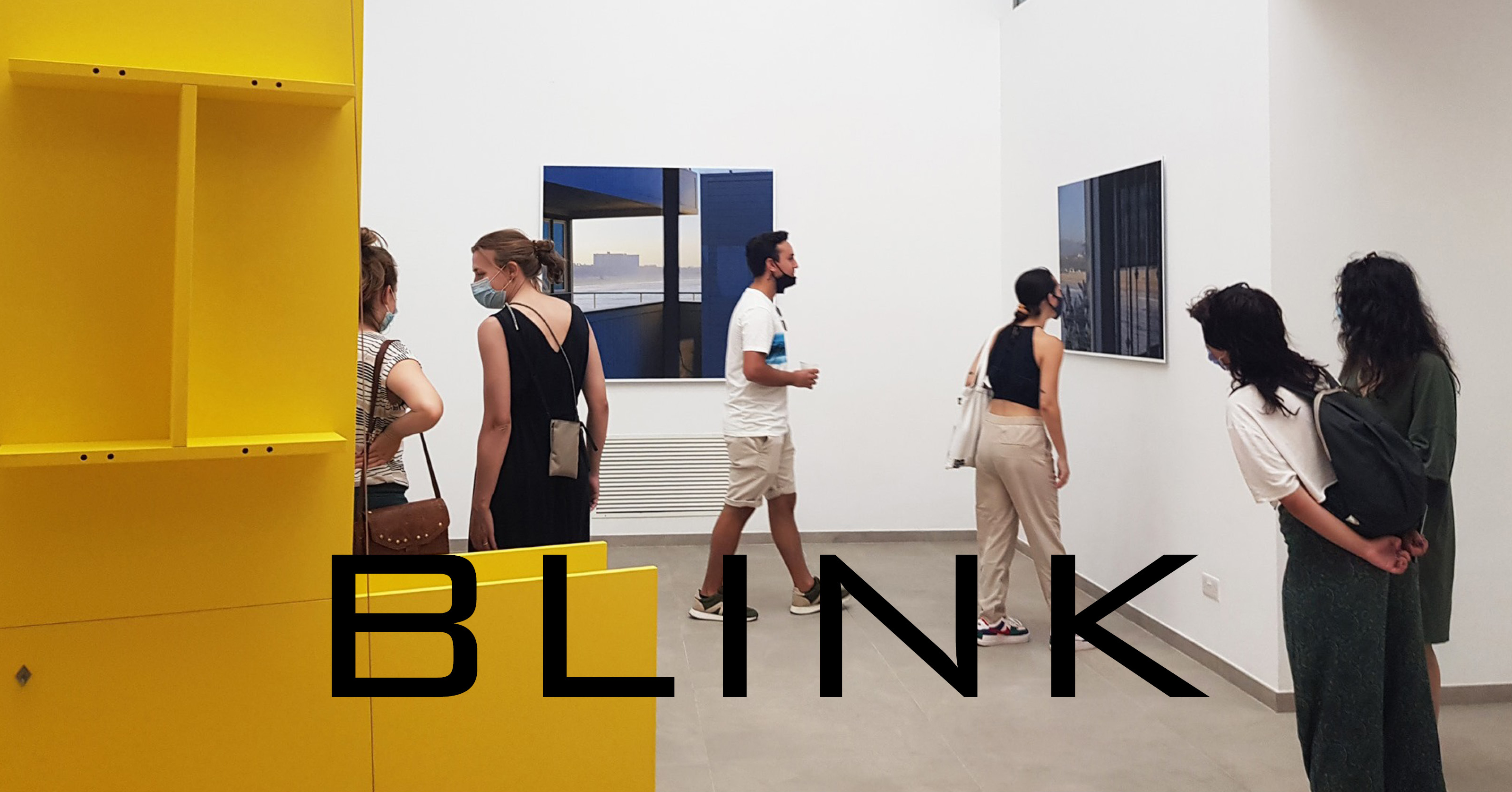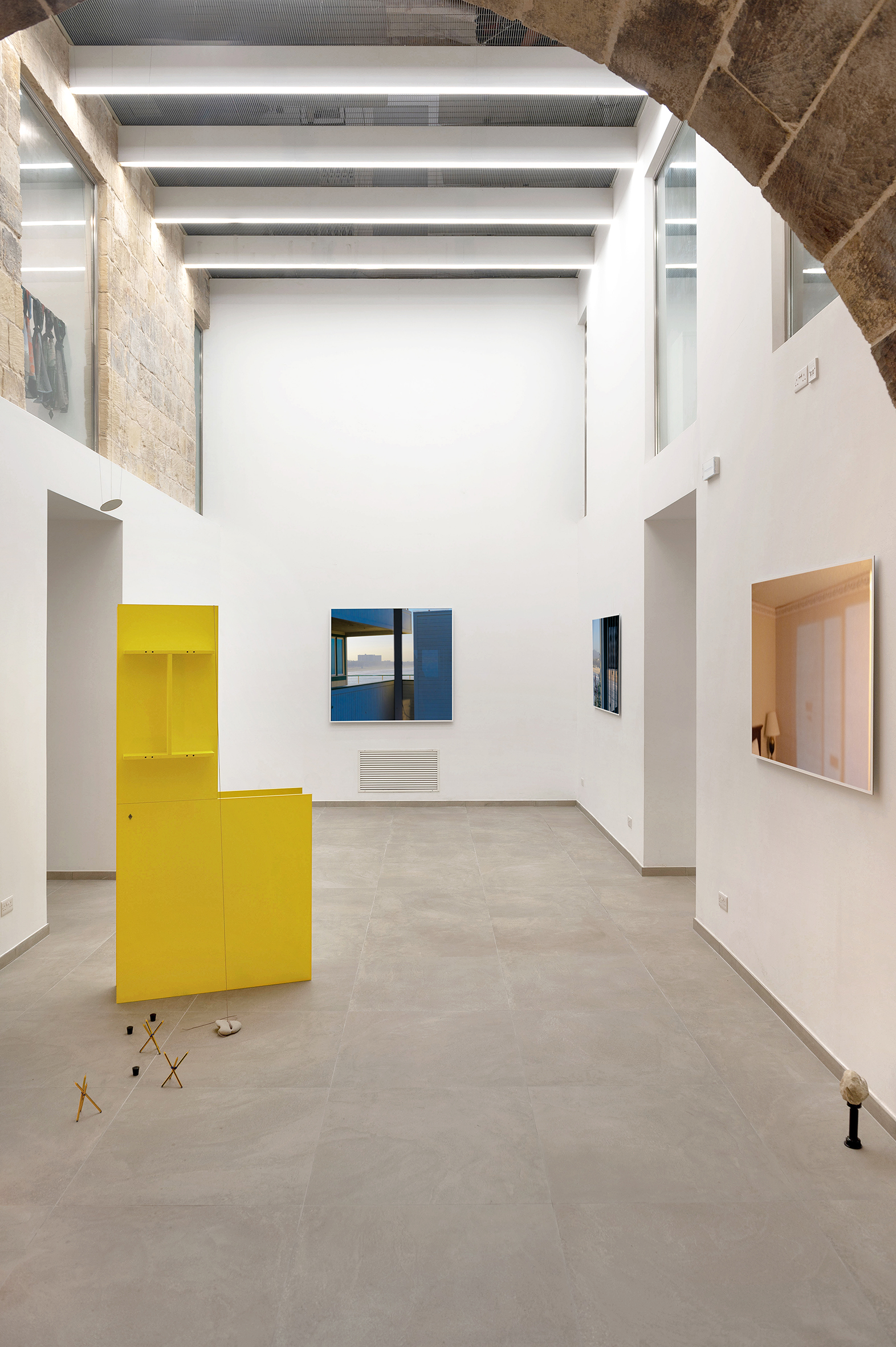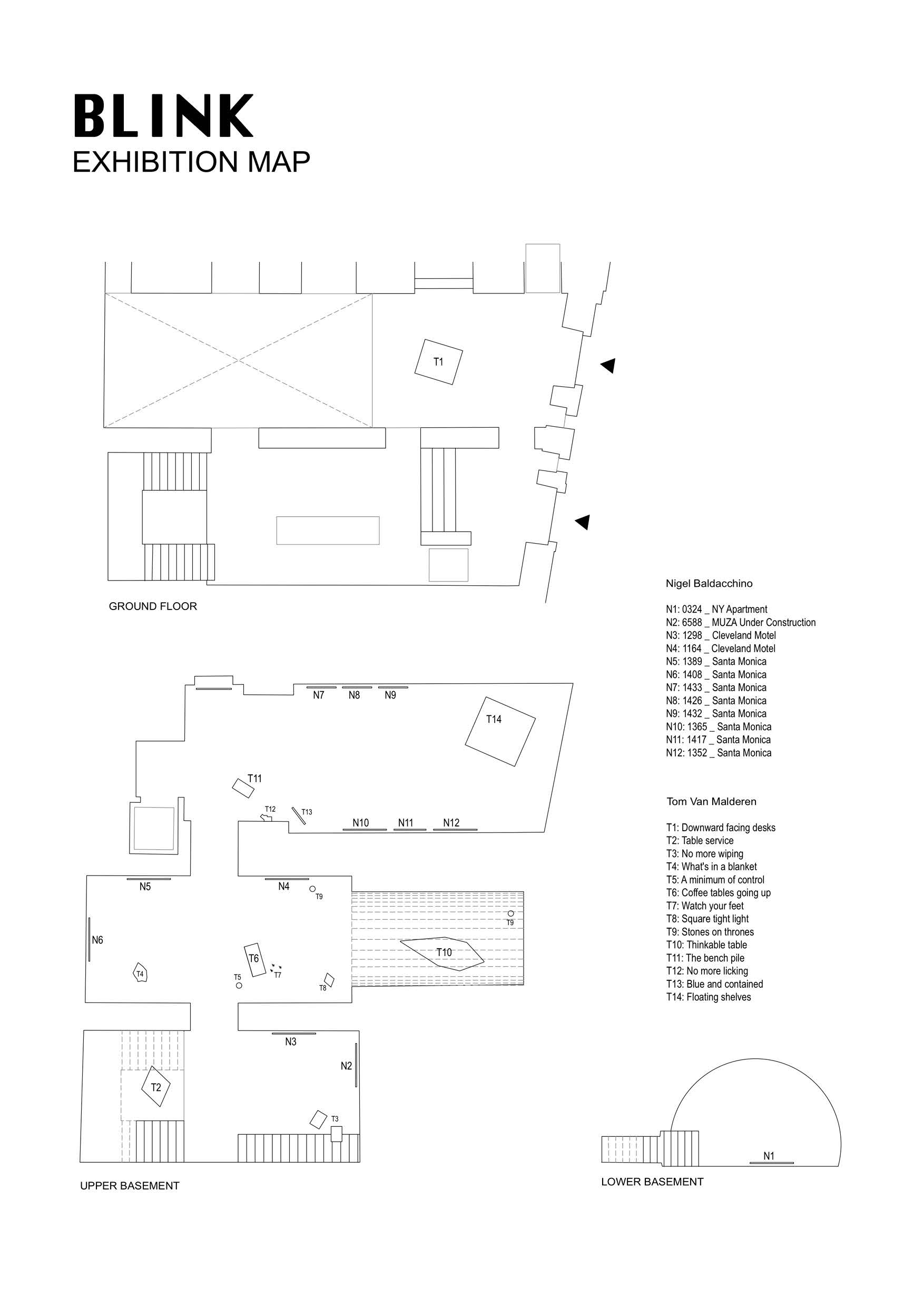Blink
Blinking is an automatic gesture that half-knowingly punctuates our perception of visual reality in time. It ruptures the continuum of sight, thus lending it an inescapable and unceasing rhythm. It is also a mundane act of maintenance; we need to shut our eyes, so as to be able to keep them open. The work presented here is concerned with rhythms of life, and ways of perceiving. Like a blink, the work ruptures automated and familiar cycles, propelling them forward then back again.
exhibition interview with Ann Dingli link



In his sculptural work, Tom Van Malderen summons and repurposes objects and elements from day-to-day life, usually taken for granted (not unlike blinking), putting into question what the elements that make up our quotidian routines can mean and represent. He decomposes our experience of objects, proposing a new time-frame to the encounter with furniture, creating a rupture in our daily rhythm. He asks us to imagine what can happen if we are not preoccupied with the usual function, habit and necessity that furniture triggers.
Nigel Baldacchino's photographic work highlights the way windows articulate light and vision throughout the day in our urban reality. As days and seasons go by, windows modulate the interior onlooker’s perception of what is exterior, and vice versa, by reflecting, refracting (when half open, at an angle) and transmitting light in different degrees. Nigel's work freezes specific instances in these cycles that, like blinking, highlight their perpetual motion. A blink is also a moment of exception, to one's gaze, much like a window is a moment of exception to the opaque presence of a wall.
Nigel Baldacchino's photographic work highlights the way windows articulate light and vision throughout the day in our urban reality. As days and seasons go by, windows modulate the interior onlooker’s perception of what is exterior, and vice versa, by reflecting, refracting (when half open, at an angle) and transmitting light in different degrees. Nigel's work freezes specific instances in these cycles that, like blinking, highlight their perpetual motion. A blink is also a moment of exception, to one's gaze, much like a window is a moment of exception to the opaque presence of a wall.



(Text:
Anne Immelé, September 2021)
BLINK
The mind is not prisoner enough of the eye.
Jonas Mekas
The idea we have of the world would be overturned if we could succeed in seeing the intervals between things. Maurice Merleau-Ponty, The Film and the New Psychology,
Lecture delivered March 13, 1945, at l'Institut des Hautes Etudes Cinématographiques (IDHEC)
In the unique space of the gallery is an assembly of works questioning representation and perception. Nigel Baldacchino’s photographs give us interior spaces, rooms and windows whilst Tom Van Malderen’s sculptures are made of furniture material and decorative elements. The materials in Tom Van Malderen’s pieces echo the hotel rooms in Nigel Baldacchino’s photographs. These forms, places and materials are solid and familiar but the exhibition leaves the spectator with a feeling of ambiguity and confusion.
BLINK
The mind is not prisoner enough of the eye.
Jonas Mekas
The idea we have of the world would be overturned if we could succeed in seeing the intervals between things. Maurice Merleau-Ponty, The Film and the New Psychology,
Lecture delivered March 13, 1945, at l'Institut des Hautes Etudes Cinématographiques (IDHEC)
In the unique space of the gallery is an assembly of works questioning representation and perception. Nigel Baldacchino’s photographs give us interior spaces, rooms and windows whilst Tom Van Malderen’s sculptures are made of furniture material and decorative elements. The materials in Tom Van Malderen’s pieces echo the hotel rooms in Nigel Baldacchino’s photographs. These forms, places and materials are solid and familiar but the exhibition leaves the spectator with a feeling of ambiguity and confusion.

IN THE INTERVAL
BLINK is the name of the exhibition and the automatic movement of fluttering eyelids:
Blinking is an automatic gesture that half-knowingly punctuates our perception of visual reality in time. It ruptures the continuum of sight, thus lending it an inescapable and unceasing rhythm. It is also a mundane act of maintenance; we need to shut our eyes, so as to be able to keep them open. The work presented here is concerned with rhythms of life, and ways of perceiving[1].
Blink is the fluttering of eyelids comprising rhythm and interval. In this moment, attention must focus on what’s unfolding between two parts of a sculpture by Tom Van Malderen or what is happening between two of Nigel Baldacchino’s works. The tryptic and diptych Santa Monica (2019), for example, perfectly illustrate the rhythmic play at work in transformed spaces of perception. Intervals and lines of rupture and continuity are particularly important in Tom Van Malderen’s Thinktable table(2021), Floating shelves (2021) and The Bench pile (2021). They enable a play of forms. Taking off from function and regular use, Tom Van Malderen’s objects break open different imaginaries, intimating at times an absurd fantasy and at others, societal concern.

In the same manner, Tom Van Malderen’s literal use of concrete objects and materials for sculpture complicates perceptive space. The intervals within the objects at hand surpass the divide between use and reverie. The elements enact gestures of repetition and variation which give way to a free flow of understanding and empathy for the manufactured objects.

BLACK ISN’T BLACK
Blink refers to retinal perception but also to the whole spectrum of what it means to perceive. It is what flickers, sparkles and trembles. The perceiving eye hesitates, and between what is seen and what is felt is a zone of incertitude. Obscurity further disturbs vision in Nigel Baldacchino’s work. In Muza under construction (2018), for example, we make out the corner of a wall and a plinth but can we be sure?
In the moment we blink, in the brief lapse of time in which eyelids rest on eyeball, darkness takes over. It is not pitch black, it is made of nuance and halos. James Joyce’s Ulysses speaks of the “ineluctable modality of the visible” and commands to “Shut your eyes and see”. Closing the eyes brings back the image just perceived. It’s almost entirely gone but we can feel it. This is how Blink moves beyond retinal perception towards the tactile, towards a mode of perception so well captured in Maurice Merleau-Ponty’s The Visible and the Invisible.
Subtle nuance and the flow from one range of colour to another are important in Nigel Baldacchino’s work. We see this in the colours of the sky over the sea at the close of day, where transformations of light and colour happen almost unperceived. These are chromatic shifts at play in photographed space. The darkness at work in Muza under construction (2018)or in Santa Monica (2019) is a diffuse presence of perceptive unease which reminds us that the aim here is not to give evidence of the visible. To take a photograph is to transcend the tangible, to disturb an apparently familiar view.
Tom Van Malderen’s stable objects move within a sense of perceptive ambiguity. The spectator’s imagination is met each time with a singular and renewed sense of obscurity.

Tom Van Malderen presents two main types of works here: the arrangements Coffee tables going up (2021) and The bench pile (2021) and the individual objects strangely bursting into space like the doormats in No more wiping or the tea towel of What’s in a blanket. These objects or arrangements transcend their primary function enabling the spectator to escape the ordinary. The artist/designer’s project is to give an imaginary life to standard objects and furniture. This imaginary life comes to be through slips in modes of use and displacements of context. These subtle and subversive gestures of the artist disturb, amuse and disorient the spectator’s perception.
‘What you see is what you see’ is one of American minimalism’s most contested statements. For artists like Donald Judd or William Morris, creation was about making ‘specific objects’, pure, simple and literal objects not lending themselves to interpretation, unique objects to perceive in the here and now, where interpretation falls back on itself. With Tom Van Malderen's work, one wonders if the opposite is true, if “What you see is not what you see”. Subversion of context and understanding is typical of a complex and contemporary positioning which is neither confined to one place nor heir to a specific artistic movement:
“Let’s query those fabricated boundaries between figuration and abstraction, between rationality and intuition, between a strict minimalism and a sense of narrative!”[2] The arrangements move away from a minimalist heritage first and foremost because their internal structure provokes connections between parts, a fantasy in details and a pull to mystery. They are an invitation across different temporalities like Thinktable table (2021): is it a ship moving into the future or a dining table under which the artist plays child?
POETICS OF MOVEMENT
Reading George Perec’s Species of Spacesis key to understanding Tom Van Malderen’s arrangements, himself an avid reader of Perec, but allows us also to enter the intermediate spaces at work in the photos of Nigel Baldacchino. The opening lines of Species of Spaces are particularly fruitful and allow the spectator an active understanding of the exhibited works:
The space of our lives is neither continuous, nor infinite, nor homogeneous or isotropic. But do we know exactly where it breaks off, where it curves, where it disconnects and comes together? We confusedly experience cracks, gaps and points of friction, sometimes vaguely aware that something is stuck, that it breaks loose or collides. Though we seldom seek to learn more about it and more often than not, wander from one spot to another, from one space to another, without measuring, without taking into account or considering the course of space.
This is an interrogation of space in terms of a crossing, a voyage to the heart of the quotidian. The narrative itself is a happening. Similarly, in the text accompanying Tom Van Malderen’s work, the furniture speaks a narrative fantasy:
The furniture would like you to know that it is very charmed by your increased interest and attention, to say the least. It would also like to declare that it is – as much as yourself and the artist’s work – in constant motion, with its existence and meaning changing according to time, location, events and other stuff going way beyond your human-centric concerns.
In Nigel Baldacchino’s photographs, we find windows, furniture and objects usually associated with habitats. Variations of light cross windows, provoking changes and movements in perception. These constant mutations in perception are active in both artists’ works, transcending the apparent immobility of the photographs and the arrangements. A poetics of movement is at work.
[1] Exhibition text.
[2] From the artist’s website.




exhibited works:
Home is the new Travel / T1 Downward Facing Desks / T2 Table Service / T3 No more Wiping / T4 What's in a blanket / T5 A minimum of Control / T6 Coffee Tables going up / T7 Watch your Feet / T8 Square tight Light / T9 Stones on Thrones / T10 Thinkable Table / T11 The Bench Pile / T12 No more Licking / T13 Blue and Contained / T14 Floating Shelves

photo credits: Norbert Attard, Nigel Baldacchino & Tom Van Malderen